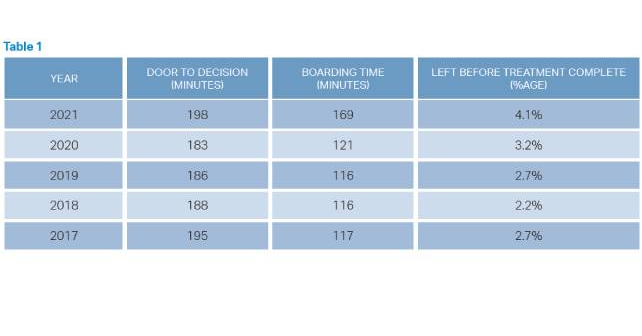
The role of the emergency department (ED) and emergency physicians has been made dramatically more important due to the pandemic.
Explore This Issue
ACEP Now: Vol 41 – No 08 – August 2022Performance of EDs in 2020 and into 2021 changed abruptly due to the pandemic, with subsequent changes in health care delivery and incidence of certain diseases. The members of the ED Benchmarking Alliance (EDBA) are surveyed annually and those surveys provide insight into important trends in ED operations. Definitions have been previously published.1
From the results of the 2021 EDBA performance measures survey, EDs are seeing higher acuity, more adults, more EMS patients, making more use of diagnostic tests, transferring more ED patients, and boarding the early time of patients who are in need of inpatient services.
Large losses in patient volume, which began in 2020, started to reverse in 2021. After volume drops of about 15–20 percent in overall ED volumes in 2020 compared to 2019, volumes recovered in 2021 to about a five to 10 percent decrease from 2019 volumes.
Patient acuity increased, as measured by physician level of service and by the percentage of patients that were admitted to the hospital from the ED. There are ongoing indications that patient acuity is increasing across all sizes and types of full-service EDs. The cohort system used in the EDBA survey process has data comparators for adult and pediatric EDs, and for EDs that see patients in 20,000 volume bands. Higher volume EDs reported disproportionately higher acuity, higher use of diagnostic testing, and longer patient processing times.
There is a significantly lower percentage of children presenting to EDs that are not designated as children’s hospitals, as I described in my previous article. For general community EDs, the decrease in visits by patients under age 18 has moved from about 16 percent in 2020 to about 13 percent in the data for 2021.
Patient arrival by EMS increased, and more of those patients were admitted. About 19 percent of ED arrivals in 2021 came by ambulance and 37 percent of those patients were subsequently admitted.
ED patient intake processing remained intact, which is an incredible accomplishment in a very difficult year. “Door to Bed” time remained stable with a median time of about seven minutes, and “Door to Doctor” time at about 12 minutes. The long-term trends for these metrics remained intact, as they have decreased in most years since 2008 when the intake time was about 41 minutes.
Pages: 1 2 3 | Single Page




No Responses to “The Big Recovery: Emergency Department Operations in 2021”